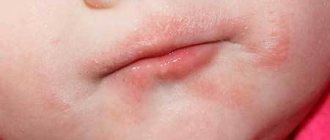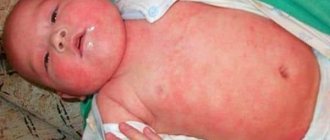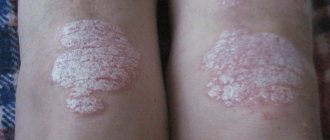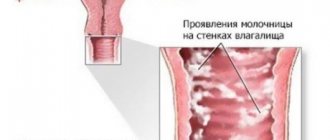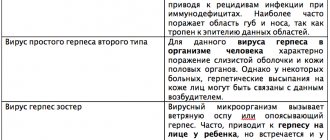Causes of streptococcal infection
Streptococcus is a spherical microorganism that lives on the human body. This pathogenic bacterium is found on the surface of the skin, in the genital tract, in the oral cavity and throughout the digestive tract. Streptococci are transmitted from person to person through direct contact, causing a large number of different diseases.
Routes of transmission of streptococcus:
- airborne;
- contact and household;
- through damaged skin.
Streptococcal infection includes all diseases caused by streptococcus. In this case, rheumatism, glomerulonephritis and infective endocarditis are usually considered separately, since they are complications of a primary throat infection.
Pathogenic microorganisms are divided into three types:
- alpha-hemolytic streptococcus (viridans) – causes incomplete hemolysis (destruction) of erythrocytes (red blood cells);
- beta-hemolytic streptococcus - causes complete hemolysis;
- non-hemolytic streptococcus.
Each of the streptococci has its own special antigens on the cell wall. Depending on the type of antigen, each group of bacteria has its own identification mark (A, B, C... to U). In medical practice, the following types of streptococci are of greatest importance:
- Streptococcus pyogenes (beta-hemolytic streptococcus group A) – causes scarlet fever, sore throat, erysipelas, rheumatism;
- Streptococcus pneumoniae – causes pneumonia in adults and children.
Symptoms of streptococcal infection
Signs of the disease depend on the location of the streptococcus. Diseases caused by this microorganism include:
- erysipelas;
- abscess;
- scarlet fever;
- angina;
- pharyngitis;
- rheumatism;
- glomerulonephritis;
- pneumonia;
- bronchitis;
- meningitis;
- endocarditis;
- sepsis.
Propionibacterium acnes
Often cited as the cause of acne vulgaris, Propionibacterium acne (PA) is a Gram-positive anaerobic bacilli that produces propionic acid, a byproduct of its metabolism. PAs inhabit the sebaceous glands, feed on fatty acids in sebum, and are sensitive to ultraviolet radiation.
It is believed that PA causes diseases such as folliculitis, sarcoidosis, as well as systemic infections leading to endocarditis. Sometimes PA provokes SAPHO syndrome (synovitis, acne
, pustular rashes, hyperostosis and osteitis) is a chronic systemic inflammatory disease. PAs produce free fatty acids in the sebaceous glands. This byproduct of their vital activity irritates the walls of the follicles and causes inflammation, which leads to skin infections.
The most common condition associated with PA is acne
, affecting up to 80% of adolescents. However, there are factors that predispose them to their appearance: the predominance of male hormones, drug therapy (hormonal or contraceptive), stress and heredity.
Non-inflamed acne is open or closed comedones, inflamed acne is nodules, pimples, pustules and blisters.
Like Staphylococcus epidermidis, PAs become a cause of postoperative infections. Artificial joints, catheters and heart valves transport skin microflora into the body. As a result, systemic infections occur, and then sepsis or endocarditis. Another way PA can enter the body can be through eye damage or ophthalmic surgery. This leads to endophthalmitis - inflammation of the inner eye with temporary loss of vision. Late onset of infection is most often the result of the low virulence phenotype of PA.
Treatment of such diseases depends on many factors. There are many products available to treat and prevent acne, such as benzoyl peroxide and topical antibiotics, which disinfect the skin and protect it from bacteria. External retinoids relieve inflammation of the follicles. Oral antibiotics are prescribed to patients with moderate acne. In addition to reducing the external manifestations of the disease, antibiotics also have an anti-inflammatory effect. However, the only drug currently available that leads to permanent remission is isotretinoin, a component of vitamin A. Rare systemic infections, including endocarditis, that develop after surgery in patients with low immunity are effectively treated with penicillin or vancomycin.
The main factors contributing to the development of acne are keratinization of the hair roots, increased sebum production and excessive amounts of PA. Although these bacteria are often associated with acne, they also inhabit the microflora of completely healthy people. And studies prove that antibiotics first of all relieve inflammation and only then inhibit the growth of PA. The widespread occurrence of propionibacteria acnes on healthy skin suggests that they are mutualists and not parasites.
Erysipelas
The symptoms of streptococcal infection in erysipelas are quite easy to recognize. The disease begins acutely with an increase in body temperature to 39–40 °C, the appearance of a severe headache and other signs of intoxication. After 6-12 hours from the onset of the disease, an area of redness (erythema) appears on the skin. The spot is sharply limited from healthy skin and in its shape resembles flames or a geographical map. The skin at the site of the lesion is swollen, tense and hot to the touch.
Advice
If spots appear on the skin, consult a doctor immediately!
In some cases, against the background of erythema, blisters filled with clear liquid appear. Over time, they disappear, and erosions and ulcers can form in their place. This form of the disease is more common in adults. In a child, bullous erysipelas occurs when the immune system is sharply reduced.
Useful: Changing a breastfed baby’s stool – is there a reason for concern?
Streptococcal infection on the skin persists for 5-15 days. After all symptoms subside, lymphostasis (impaired lymph outflow) may develop. Lymphostasis ultimately leads to elephantiasis (an increase in the size of the limb). The cause of this condition is the same streptococcus, which once penetrated through damaged skin.
Diphtheria corynebacterium (Corynebacterium diphtheriae)
These are gram-positive, non-motile anaerobic bacteria, common inhabitants of the skin microflora. They are divided into two types: diphtheria and non-diphtheria. Diphtheria corynebacteria (DC) are, in turn, divided into toxicogenic and non-toxicogenic. The latter can provoke blood poisoning, septic arthritis, endocarditis and bone marrow inflammation. Both species are typically present in skin ulcers of alcoholics, injecting drug users, and in places with poor hygiene and socioeconomic levels. Vaccination has rid developed countries of diphtheria, but the disease still persists in people from the lower classes and those who have not been vaccinated.
Streptococcal sore throat and pharyngitis
The disease most often occurs in children. When a child is infected with streptococcus, the body temperature rises, chills and headache occur. When examining the pharynx, you can see swollen and reddened tonsils. On the third day of the disease, a yellowish-gray coating forms on the tonsils, which is easily removed with a spatula. When a child has a sore throat, the cervical lymph nodes always become enlarged, and a streptococcal throat infection also develops.
Advice
Do not self-medicate if a sore throat develops!
Streptococcal pharyngitis is characterized by a sore throat that gets worse when swallowing. Symptoms of intoxication appear, chills occur, and body temperature rises. A child under three years of age often vomits once due to a rise in temperature.
If you suspect streptococcal infection, do not delay your visit to the doctor. Diagnosis and treatment should be carried out as soon as possible. Streptococcal throat infection is dangerous because it can lead to damage to the heart, kidneys and joints at any time. Infectious endocarditis, glomerulonephritis and rheumatism are the most dangerous complications of streptococcal infection.
Scarlet fever
The cause of this disease also lies in streptococcal infection. Mostly children of preschool age are affected. The disease begins with an increase in body temperature to 38–39 °C. 24 to 72 hours after the fever starts, the child develops a small rash on the skin. The rashes are localized on the cheeks, sides of the body and groin. The area of the nasolabial triangle is never affected in scarlet fever. On the 2nd–3rd day of illness, the child’s tongue becomes bright red. Diagnosis of the disease is based on typical signs of infection. If necessary, laboratory tests are carried out.
Useful: What to do if a child gets his finger caught in a door?
Pneumonia and bronchitis
Streptococcal infection can affect more than just the upper respiratory tract. In children and weakened adults, microorganisms often descend into the bronchi and lungs, causing the development of inflammation. With these diseases, body temperature rises and a severe cough appears. Streptococcal pneumonia is especially dangerous in newborns, whose immune system is just beginning to form. In this case, infection with pneumococcus can lead to the development of sepsis and even the death of the child.
Causes of pathology
As already mentioned, the causative agent of streptoderma is the microorganism streptococcus. It cannot cause the disease on its own, but when a number of factors act on a fragile child’s body, it is immediately activated. Let's look at its main “helpers”:
- Weak immunity. A general decrease in the level of the body's defenses reduces its chances of resisting any infection. In this case, all mucous membranes (nose, mouth, eyes) and pores can serve as entrance gates. When local immunity decreases, individual areas of the skin may be affected.
- Violation of the integrity of the epidermis. Any wounds, even the smallest ones, cuts, ulcers can lead to the development of an infectious process, dermatitis of various origins.
- Failure to comply with personal hygiene rules. If you neglect the shower, sooner or later diaper rash appears on the skin and, as a result, the addition of streptococcal flora, which leads to suppuration and the development of streptoderma (we recommend reading: how is diaper rash treated in children?).
- It happens that metabolic disorders can also provoke streptococcal skin infections.
Diagnosis of streptococcal infection
Laboratory diagnosis of the disease begins with the collection of material for inoculation on nutrient media. This can be blood, urine, scrapings from the nasopharynx and pharynx, or discharge from the genital tract. After collecting the material, an analysis is performed in the laboratory to determine the causative agent of the disease. Diagnosis of infection also includes determining the sensitivity of identified microorganisms to certain groups of antibiotics.
Analysis for the study is taken strictly before the start of antibacterial therapy. To get the result you need to wait from 3 to 5 days. In some cases, analysis can be performed faster using special test systems. Unfortunately, such diagnostics do not always bring reliable results, so experts give preference to proven and reliable methods (bacteriological culture). The rapid test is used only to detect group A streptococci.
Stages of streptoderma in a child: how does the disease begin?
Any infectious disease begins with the incubation of the pathogen. Streptoderma is no exception. A child can be a passive carrier of streptococcus for a long time and not get sick, but be infectious to others. Under the influence of factors already known to us, the pathological process starts. From this moment until the first signs, on average, it takes from two to ten days. At this time there are no clinical manifestations.
Depending on the depth of damage to the dermis, three stages of streptoderma are distinguished:
- Bulous (vesical). Characteristic damage to the surface layers of the skin with the formation of small blisters and small areas of inflamed epidermis. Small red spots appear on the child’s skin, in the center of which, after 24 hours, blisters with purulent contents appear. Their number varies from a few pieces to dozens. The opening site is covered with a yellowish crust - scab. If you touch it, it easily moves and exposes the inflamed surface of the skin. Such a rash is united into small and large conglomerates and looks like growths of scales. After recovery, no signs of the disease remain on the skin.
- Nonbulous. It is characterized by damage to the deeper layers of the epidermis. Large blisters and ulcers develop - streptococcal ecthyma. The condition of the children ranges from moderate to severe. After the yellow-green crust is rejected, deep ulcerative irregularities remain on the skin. A similar shape is typical for the limbs. It takes a long time to heal.
- Chronic course. Occurs when the process of strepodermia is neglected or improperly treated. Large areas of damage to the dermal layer of the skin are formed. After recovery, the skin in these places is pigmented and peels off.
This is what bullous streptoderma looks like on the skin of children
Treatment of streptococcal infection
Having found out the causes of the pathological process in the oral cavity or on the skin, doctors begin to develop a treatment regimen. After the analysis is obtained and its results are interpreted, antibacterial therapy is prescribed. Treatment of streptococcal infection can never be done without antibiotics - the risk of the pathogen spreading to internal organs is too high. Glomerulonephritis, rheumatism and other serious complications of angina develop precisely in the absence of timely antibiotic therapy.
Penicillins or cephalosporins are used to treat streptococcal infections. Drugs from these groups effectively cope with the disease, leaving streptococcus no chance. Unfortunately, quite often during therapy it is discovered that microorganisms are resistant to the selected antibiotics. An allergic reaction to the drugs is also possible. In these cases, antibiotics from the group of macrolides or lincosamides are prescribed.
Advice
Do not stop antibiotic therapy before the time stated by your doctor!
In some cases, antibiotics are prescribed even before the examination results are received. In this case, broad-spectrum drugs are used that can destroy the most famous pathogens. When the analysis is ready, the treatment regimen may change in accordance with the result obtained.
Helpful: Is it possible to get pregnant while breastfeeding?
Streptococcal infection of the nasopharynx involves not only systemic, but also local use of antibiotics. For this purpose, “Bioparox”, “Tonsilgon N” and other drugs that affect the causative agent of the disease are most often prescribed. The duration of therapy is from 5 to 10 days. As a rule, this interval is enough to eliminate cough, sore throat and other manifestations of infection.
Antipyretic drugs are used to reduce body temperature. This can be paracetamol or ibuprofen - both of them are effective in dealing with the symptoms of fever. Antipyretics are used at temperatures of 38 °C and above. At lower thermometer values, it is not recommended to interfere with the body, disrupting the natural processes of regulation of thermogenesis.
Advice
Children with a history of seizures should not wait until the temperature rises above 38°C.
Streptoderma treatment complex
Complete recovery from streptoderma is possible only with complex treatment. It consists of the gradual use of etiotropic, pathogenetic and symptomatic agents. Treatment tactics, including a combination of certain drugs, should be selected by a dermatologist.
Skin treatment and antiseptics
Before starting therapy, it is necessary to treat the affected areas of the skin. To do this, the phlyctenes are opened at the base with sterile needles, cleaned of necrotic tissue and washed with a 3% solution of hydrogen peroxide.
The lesions are treated with antiseptic agents:
- brilliant green 1%;
- potassium permanganate 0.1%;
- fucorcin;
- chlorhexidine alcohol 0.5%;
- nitrofural 1%;
- methylene blue 1%;
- salicylic alcohol 2%.
The drug is applied locally using a cotton swab. After complete drying (20 minutes), apply ointments or compresses. Antiseptic treatment is carried out 2-4 times a day during the entire course of treatment.
Local preparations and ointments
In cases where the lesions are single, the general condition and immunity are normal, treatment is carried out with external drugs. These are medicines with antibacterial active substances.
Preparations:
- Gentamicin;
- Triderm;
- Baneocin;
- Retapamulin;
- Bactroban.
The ointments are applied 2-3 times a day in a thin layer to the treated affected areas. The duration of treatment depends on the shape and extent of the lesion.
After the formation of crusts, agents with keratolytic, anti-inflammatory and antiseptic properties are used. Preparations: salicylic, syntomycin, zinc ointments.
For slit-like impetigo, 2% silver nitrate is used. Cracks are lubricated 2-3 times a day.
Antihistamines
They are prescribed only for severe allergic reactions accompanied by unbearable itching. Third generation antihistamines are selected for treatment.
Medicines:
- Claritin;
- Levocabastine;
- Zyrtec;
- Telfast;
- Terfenadine.
Despite the fact that third-generation drugs have a small number of side effects, they must be selected by a doctor. This is in addition to possible cardiotoxic effects, the risk of which increases when combined with antibiotics.
Systemic antibiotic therapy
The decision on internal use of antibiotics is made in severe and diffuse forms of streptoderma, lack of therapeutic effect after a course of treatment with local drugs.
Indications for systemic treatment include the addition of regional complications: lymphadenitis, lymphangitis.
Penicillin drugs have good antistreptococcal activity. Therefore, they are the drugs of choice. If the patient has hypersensitivity to penicillins, drugs of other groups are prescribed.
Medicines:
- Clarithromycin;
- Erythromycin;
- Amoxicillin;
- Flemoxin solutab;
- Ciprofloxacin;
- Augmentin.
Medicines are used in the form of oral tablets, intramuscular or intravenous injections. The average course of treatment is from 5 to 14 days. Probiotics are prescribed during treatment.
Immunotherapy
Immunotherapy is prescribed for chronic streptoderma, which occurs with constant relapses at least once every 3 months. Indications for use are always proven cases of immunodeficiency.
Immunostimulating agents:
- thymus preparations: Taktivin, Timalin;
- γ-globulin preparations;
- synthetic chemicals: Isoprinosine, Levamisole, Diucifon;
- azoximer bromide: Polyoxidonium;
- stimulators of interferon production: meglumine acridone acetate, sodium oxodihydroacridinyl acetate.
For all chronic and sluggish forms of streptoderma, vitamin C and B vitamins are prescribed. To improve microcirculation, medications are used: Pentaxophylline, Xanthinol nicotinate.
Patients with any form of streptoderma are prescribed multivitamins for 1-2 months. Recommended complexes: Complivit, Vitrum, Multitabs.
Physiotherapy for streptoderma
After relief of acute manifestations of streptoderma, the patient is recommended to undergo a course of physiotherapy. Procedures can cure general and local immunity, regulate metabolism and microcirculation, and promote rapid restoration of the skin.
Methods:
- UV irradiation of the skin;
- UV irradiation of blood;
- laser therapy.
The radiation dose and duration of treatment are selected individually.
Folk remedies
For minor manifestations of streptoderma, traditional medicine can be used as an auxiliary treatment. Some herbal components may cause allergic reactions or do not combine well with pharmacological drugs. Therefore, before use, consultation with a dermatologist is required.
For treatment, plant components with antibacterial, anti-inflammatory, emollient and antiseptic properties are selected.
Oak bark
To prepare the decoction, crushed raw materials (1 tbsp) are poured with water (0.5 l) and boiled for 30 minutes. In the strained and cooled broth, moisten a gauze cloth and apply to the affected areas for 30 minutes 2 times a day.
Yarrow
Dry herb (1 tbsp) is poured with boiling water (250 ml) and steamed in a water bath for 30 minutes. The strained broth is used to treat conflicts 3 times a day.
Honey and pomegranate
To prepare the ointment, liquid honey and juice of unripe pomegranate berries are mixed in equal proportions and left for 3 hours. Apply the product to the affected areas 3-5 times a day.
Hairy hawkweed
The dried herb is ground to a powder. The product is used as a powder on wet surfaces 3-5 times a day.
Series
Dry raw materials (1 tbsp) are poured with water (200 ml) and kept in a water bath for 20 minutes. The strained broth is used as a lotion 3-5 times a day.
Calendula
Dried flowers of the plant (100 g) are poured with 96% medical alcohol, infused in a dark place for 7 days, shaking daily. The strained tincture is used to treat the entire surface of the facial skin 3 times a day.
Garlic
This is a herbal remedy for strengthening and stimulating the immune system. Garlic pulp (200 g) is poured with alcohol (200 ml) and left for 10 days. Shake the container with the product daily. Take 5 drops dissolved in 50 ml of milk 3 times a day. The course of treatment is at least 20 days.
Natural antibiotics
The following plants have a targeted bactericidal and bacteriostatic effect against streptococci: celandine, eucalyptus, cetraria, sage. Decoctions and infusions from plants are used to treat the skin or take them internally. Pine resin is used as a natural ointment.
All components of herbal remedies can be purchased at the pharmacy. In addition, manufacturers offer a variety of herbal preparations to strengthen the immune system, which will be useful for streptococcal infections.
Basic hygiene
With streptoderma, it is important to adhere to specific hygiene. During illness, avoid washing the skin with water in the affected areas and areas close to them.
The spread of infection throughout the body requires a complete refusal of water procedures. When conflicts are localized in areas with hair, the hair is cut off. Shaving is prohibited.
Water procedures are replaced by treating the skin with antiseptic solutions: 1% salicylic acid or 0.1% potassium permanganate. To prevent the spread of infection over large areas, the skin around the inflammation is sprayed with antibacterial agents in the form of sprays. Drugs: Terramycin, Forticlin, Monclavit-1.
All treatment procedures are carried out under sterile conditions, hands are kept clean, and contact of the facial skin with dirty objects is avoided. During illness, you need to avoid synthetic clothing that causes increased sweating.
From this video you can learn about some more methods of treating streptoderma.
Diet therapy
Therapeutic nutrition for streptodemia involves limiting fast carbohydrates and predominant proteins in the diet. It is important to include foods rich in vitamin C and B vitamins in your daily menu.
Exclude from the diet:
- baked goods made from white flour;
- potatoes, starch-containing products;
- sugar in any form;
- sweet carbonated drinks;
- sweet fruits, juices;
- refined products;
- spicy, fried, smoked, fatty foods;
- alcoholic drinks.
The following products will contribute to a quick recovery:
- any berries;
- lactic acid products;
- white cabbage, carrots, garlic, celery, sweet potato;
- parsley, spinach, ginger;
- lemon, coconut;
- whole grains: bread, wild rice, quinoa.
During illness, it is important to maintain metabolism, which is impossible without a drinking regimen. During illness, the following will be useful: herbal decoctions, berry fruit drinks, filtered water.
Prevention of streptococcal infection
Streptococcal infection is frightening not so much because of the severity of the disease as because of its complications. Even in the last century, in many regions of the country, when infected with streptococcus, bicillin therapy was recommended. Bicillin was administered once after completing a full course of antibiotics. This measure made it possible to prevent the development of complications after suffering a streptococcal throat infection or scarlet fever.
At the moment, cases of rheumatism are quite rare, so the mass use of bicillin has been abandoned. This drug is administered only if for some reason it was not possible to complete the full course of antibacterial therapy. Prevention with bicillin is also indicated for outbreaks of streptococcal infection in children's groups.
Prevention of complications after tonsillitis and scarlet fever now follows a different scheme. To prevent the development of rheumatism, glomerulonephritis and endocarditis, it is recommended to carry out a full course of antibacterial therapy for any streptococcal infections. The duration of taking antibiotics is 10 days. The drugs must be taken at a strictly defined time. Interruptions in treatment are not allowed. Only such prevention can destroy streptococcus and prevent it from entering internal organs.
Group A streptococci
Gram-positive group A streptococci (GAStreptococcus) bacteria cause both systemic diseases and skin infections. The most common manifestations: acute pharyngitis. infections of the mucous membranes and impetigo. Superficial infections caused by GAS vary depending on age and skin type. For example, pyoderma most often occurs in newborns and children. Non-purulent rheumatic fever may follow a sore throat, and glomerulonephritis may follow infections of the skin or throat. GAS has also been linked to deeper skin infections called cellulitis
and erysipelas - infections of connective and adipose tissue, respectively.
Often such diseases are associated with alcoholism
, diabetes, immunodeficiency, integumentary ulcers or injuries. Deadly fasciitis is also complicated by toxic shock syndrome. In addition, GAS can cause infections in various organs - the lungs, bones, joints, muscles and heart valves. The symptoms are the same as those of Staphylococcus aureus diseases.
Treatment options depend on the location, severity, and type of infection. Superficial diseases, such as impetigo, are easily eliminated with external antibacterial ointments - mupirocin or fusidic acid. More serious infections are treated with oral antibiotics such as penicillin, erythromycin, or clindamycin. In case of severe necrotic tissue lesions, surgical excision is inevitable.
However, according to some studies, GAS produce certain substances that stimulate the production of collagen and other cellular components. Therefore, it is believed that some virulent properties of GAS bring benefit rather than harm to the body.
